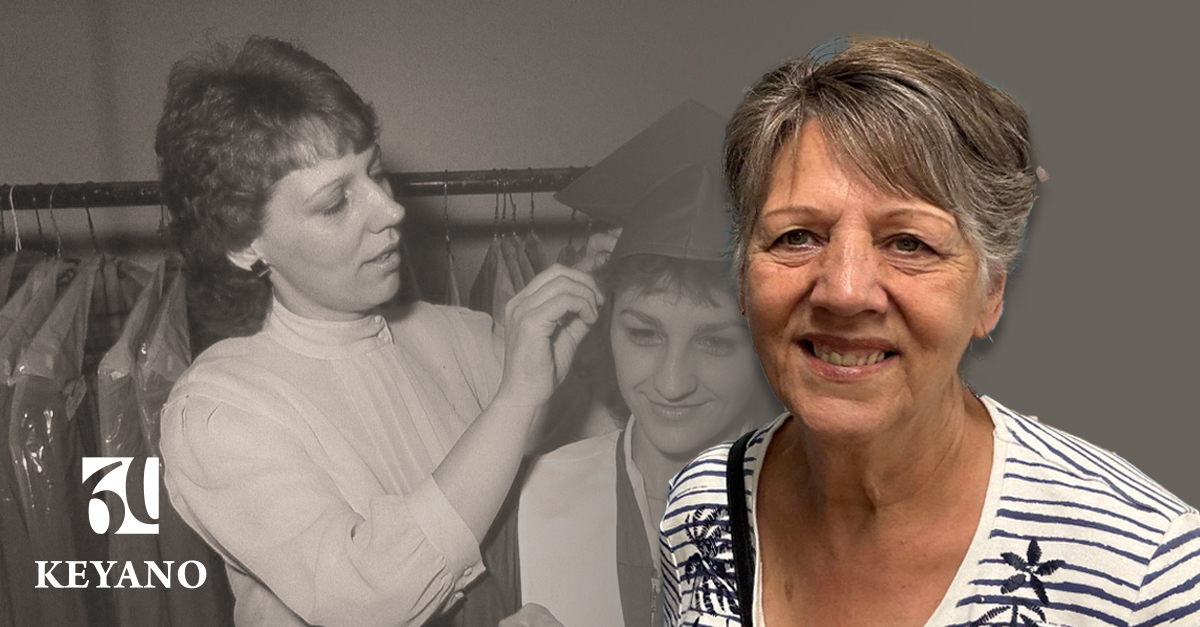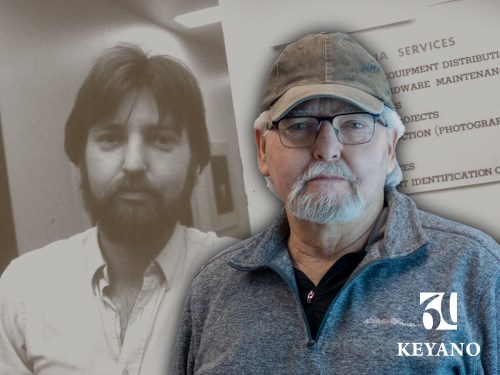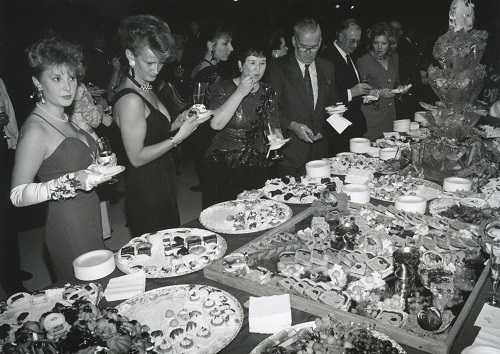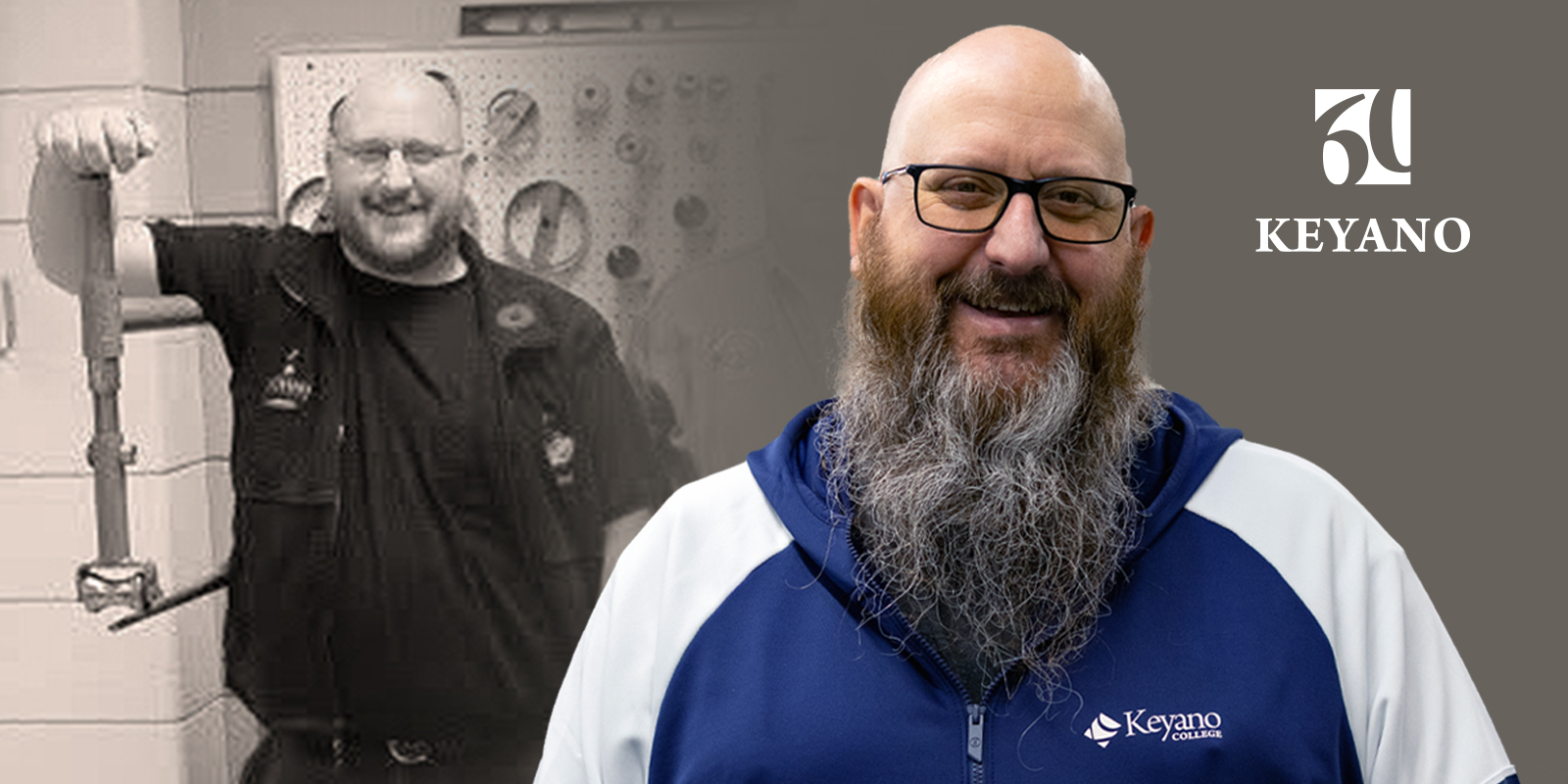 If you’ve spent time at Keyano College over the past few decades, you probably know Gwen. And if you know Gwen, you know her warm laugh, quick wit, and an open-door policy that turned her office into a safe haven for generations of students.
If you’ve spent time at Keyano College over the past few decades, you probably know Gwen. And if you know Gwen, you know her warm laugh, quick wit, and an open-door policy that turned her office into a safe haven for generations of students.
Gwen’s Keyano journey began in the early 1980s, when she decided to re-enter the workforce after 12 years as a stay at home mom. In the 70s,she and her husband moved from Saskatchewan to Fort McMurray during the oil sands boom. While raising her young family, she enrolled in a clerical refresher course at Keyano. By the end of the program, she had landed a part-time role on campus — three hours a day that soon grew into a full-time career supporting the Keyano College Students Association (KCSA). In the later years of her career, the organization transitioned to the Student Association of Keyano College (SAKC), the name it still carries today.
Over the years, Gwen became much more than a staff member. She was a mentor, cheerleader, and sometimes “campus mom” to countless students. She advocated fiercely for their rights, encouraged them to take on leadership roles, and made sure they had the space — and the courage — to speak up. “I just hope they remember it was a safe place to go,” she says. “That’s what mattered most.”
Her time with the Student Association brought unforgettable moments — and countless laughs. There were heartwarming traditions she helped organize for students, such as the Christmas dinners, Student Recognition nights at the end of year to celebrate the changeover in student leadership, recognize their efforts, and give out the “Lounge Lizard Award”. “It was such a special event – emotional for those leaving, and exciting for the new ones coming in,” she recalled. Gwen saw leaders in the making, watching students discover talents they didn’t know they had, and celebrating as they carried those skills into their careers.
And then there were the practical jokes, like the now-legendary day students covered her office with Burt Reynolds centrefold posters. Rather than get annoyed, Gwen decided to make it even more memorable. She called campus security ahead of time and told them to pretend it was “inappropriate material” that needed to be removed immediately. The pranksters panicked — just long enough for her to let them in on the joke. It became one of those student stories retold for years, and a perfect example of how Gwen’s sense of humour turned mischief into shared laughter.
She also went above and beyond when it mattered most, whether quietly advocating for students behind the scenes or guiding them through challenges. She believed in letting them make their own mistakes — even when those mistakes made waves. One year, the student newspaper published an article, despite her gentle warning about the content. Instead of blocking them from publishing the article, Gwen treated it as a valuable learning experience. When the article sparked enough controversy on campus to make it into the local community paper, she walked the student leaders through taking responsibility, navigating criticism, and understanding the impact of their decisions — lessons she knew would serve them for life.
Her impact didn’t end at graduation. Many former students keep in touch, sharing life updates, wedding invitations, and baby announcements. Some became community leaders, business owners, and public servants. None forget the woman who believed in them.
When asked what she gained from her years at Keyano, Gwen smiles. “It for sure gave me purpose above anything else. It was nice to get up every morning to go to work with a lot of students and staff that meant so much to me and a job I loved — and if I made a small difference in their lives, it was a bonus. The culture of the SAKC was meant to make every student welcome, and hopefully they knew they came first before anything else. The student executives and the staff tried our best to create a welcoming, comfortable space.”
After retiring due to family illnesses, Gwen remains deeply connected to the Keyano community. For her, the memories aren’t just about the work, but about the people — the laughter in the office, the lifelong friendships, and the students whose paths she helped shape.
“I learned as much from them as they learned from me,” she says. “Patience, teamwork, and how to find joy in the small moments. That’s the real gift.”
Gwen’s story is woven into the history of Keyano College — proof that one person’s kindness, humour, and unwavering support can leave a legacy as enduring as the campus itself.


 Doug MacRae’s name is more than familiar at Keyano College – his legacy quite literally lives at the heart of our Clearwater Campus. The Doug MacRae Park, named in his honour, is the green space where students gather, staffs take their breaks, events are held, and community comes together – it’s a living tribute to a leader who helped shape the College into what it is today.
Doug MacRae’s name is more than familiar at Keyano College – his legacy quite literally lives at the heart of our Clearwater Campus. The Doug MacRae Park, named in his honour, is the green space where students gather, staffs take their breaks, events are held, and community comes together – it’s a living tribute to a leader who helped shape the College into what it is today.  Keyano College didn’t start with big buildings or fancy equipment. It started with people — people like Chris Chesterman, who came north in the 1970s and never left.
Keyano College didn’t start with big buildings or fancy equipment. It started with people — people like Chris Chesterman, who came north in the 1970s and never left. What began as a simple sketch on a napkin—a single fieldhouse—became a world-class facility thanks to the vision and dedication of Wayne Thomas. Under his leadership, that dream expanded into a multi-purpose complex featuring three fieldhouses with turf, synthetic, and hardwood surfaces, an indoor running track, a fitness centre, and supporting facilities. The banners lining the walls of the hardwood court stand as testaments to his efforts, for without Wayne, Huskies Athletics would not exist, nor would their induction into the Alberta Colleges Athletic Conference (ACAC).
What began as a simple sketch on a napkin—a single fieldhouse—became a world-class facility thanks to the vision and dedication of Wayne Thomas. Under his leadership, that dream expanded into a multi-purpose complex featuring three fieldhouses with turf, synthetic, and hardwood surfaces, an indoor running track, a fitness centre, and supporting facilities. The banners lining the walls of the hardwood court stand as testaments to his efforts, for without Wayne, Huskies Athletics would not exist, nor would their induction into the Alberta Colleges Athletic Conference (ACAC). Sitting in the lobby at a conference in the Kananaskis, Troy Grainger credits his time at Keyano College for giving him the confidence and government relations experience he harnesses today as the Executive Director of Community Futures Lethbridge Region. Enrolling in Keyano College as a mature student in the early 90’s came for Troy after a moment of clarity while working in maintenance at the Sawridge Hotel.
Sitting in the lobby at a conference in the Kananaskis, Troy Grainger credits his time at Keyano College for giving him the confidence and government relations experience he harnesses today as the Executive Director of Community Futures Lethbridge Region. Enrolling in Keyano College as a mature student in the early 90’s came for Troy after a moment of clarity while working in maintenance at the Sawridge Hotel. Long before spotlights swept across the Keyano Theatre stage or headliners brought the crowd to its feet, there was an evening in 1978 when guests in formal wear gathered among blueprint displays and handshake deals. That night—the Chairman’s Reception—was held not in a ballroom, but in a trades shop at the Heavy Industrial Campus, surrounded by industrial equipment and high hopes.
Long before spotlights swept across the Keyano Theatre stage or headliners brought the crowd to its feet, there was an evening in 1978 when guests in formal wear gathered among blueprint displays and handshake deals. That night—the Chairman’s Reception—was held not in a ballroom, but in a trades shop at the Heavy Industrial Campus, surrounded by industrial equipment and high hopes. If you’ve ever attended an event at Keyano College – from Convocation to Gala, a theatre performance to a final exam – there’s a good chance Bryan “BJ” Fitzgerald played a role in bringing it to life.
If you’ve ever attended an event at Keyano College – from Convocation to Gala, a theatre performance to a final exam – there’s a good chance Bryan “BJ” Fitzgerald played a role in bringing it to life.
